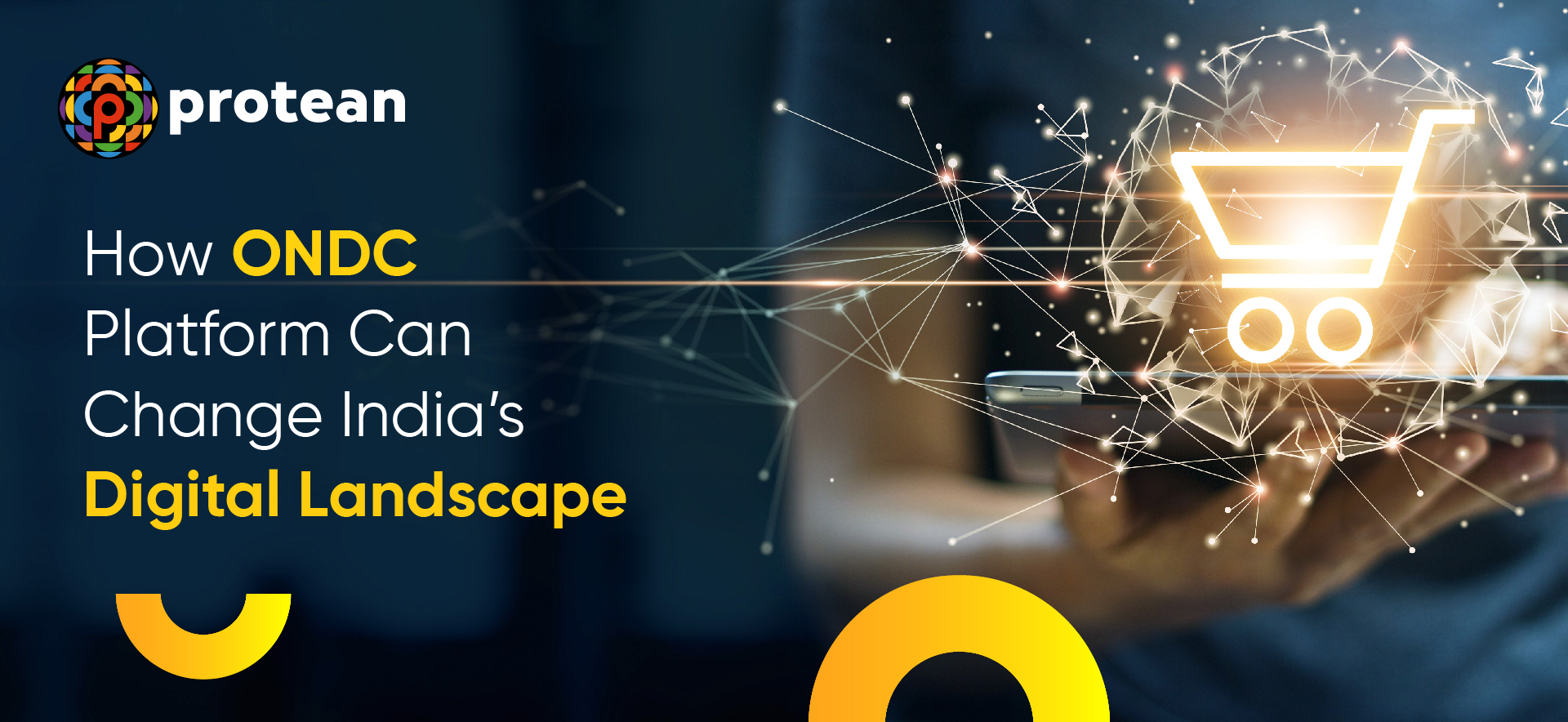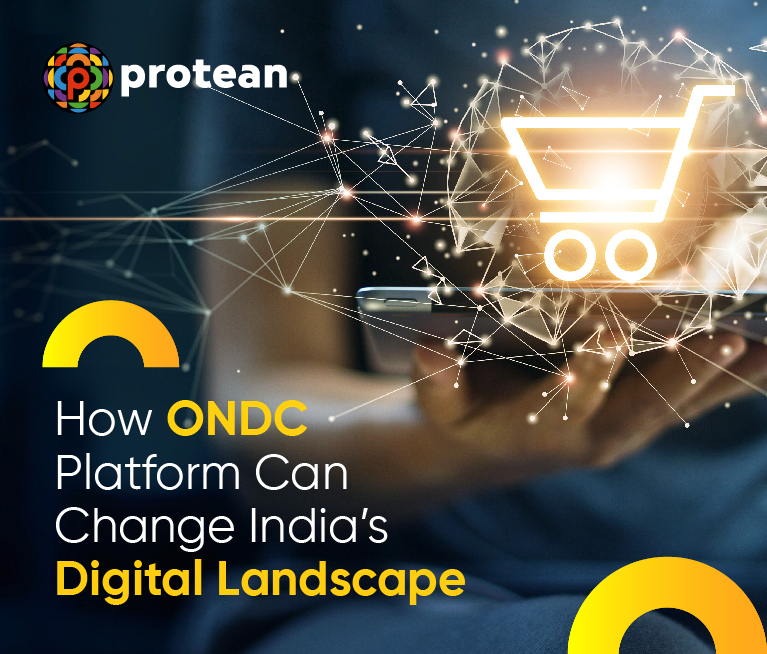Owning a digital platform has become a necessity for businesses as it ensures visibility to customers. Unfortunately, small businesses lack access to digital infrastructure and the means to maintain an online presence, which prevents them from competing with large and centralised e-commerce giants.
To provide a level-playing field for all market participants, the Government of India launched the ONDC campaign on April 2022. It aims to provide a fair ground for competition to local businesses against dominant sellers.
Considering you will be interested in knowing its growing impact in the Indian e-commerce market, we suggest you read the article.
How Does ONDC Work?
ONDC aims to remove several middlemen who try to garner profits by co-ordinating online deals between sellers and customers. It acts as a centralised platform where you can compare the rates before placing an order.
The Department for Promotion of Industry and Internal Trade (DPIIT) of the Indian Government initiated the Open Network for Digital Commerce as a private non-profit Section 8 company. They aim to instil open network protocols in India's e-commerce space.
The ONDC allows you to purchase commodities and services independently without depending on a specific digital platform. At the same time, it allows small and local businesses to adopt a digital presence and provide their products/services directly to consumers.
If you are completely a beginner in terms of interacting with an ONDC app, then comparing its functionality with the UPI will help you understand it better. Just like UPI removes payment-related barriers, ONDC helps remove multiple interfaces between a seller and a consumer.
The Unified Payments Interface or UPI allows anyone to make transactions from their bank accounts without requiring them to install the particular bank’s mobile banking app. Similarly, the ONDC enables you to search for sellers who provide quality products or services but may not be listed in the so-called popular e-commerce platforms.
This technology connects potential buyers with trustworthy sellers in the market. As a purchaser, you get to access the best deals without doing much research across different e-commerce apps. It saves your time and also promotes the local businesses that have a growth potential.
Nevertheless, to be listed in various ONDC apps, a vendor must register itself by paying a fixed amount. To accomplish this, they need to deliver their business account particulars and mention GSTIN numbers while filling up the form.
Finally, when it comes to goods delivery, the sellers face little to no issues, as ONDC has partnered with reputed courier brands for delivery. Therefore, regardless of the seller you have chosen, you will get a quick and efficient shipment. This is also because of the in-built algorithm of this open network. It favours local marketplaces instead of entities that have established their monopoly within a certain sector.
Most importantly, several middlemen get eliminated which noticeably reduces overall shipment cost and time.
What Are Some Key Features of India’s ONDC?
ONDC acts as a hub where the sellers can get information regarding spending tendencies of their customers. It is a government-backed interface that is looking forward to creating an even playing ground for small business holders.
As you may have already understood, Open Network for Digital Commerce apps aim to encourage more people to order for their requirements online. The collaborating platforms certainly hold common characteristics like:
- Interoperability
The ONDC promotes seamless interoperability among various digital commerce platforms, enabling smooth transactions and communication among multiple entities.
- Innovation
Network members get full access to open APIs (Application Programming Interfaces). Innovative features like these allow developers to create newer applications and services on top of an existing network.
- Integrated Platform
ONDC provides unified digital platforms that connect buyers, sellers, service providers, and other stakeholders, fostering a holistic ecosystem for commerce.
- Financial Inclusion
By connecting rural and remote areas, the network promotes financial inclusion, enabling people with limited access to traditional banking services to participate in digital commerce.
- Full-Proof Compliance
The ONDC network ensures adherence to relevant regulations and standards, creating a secure and trustworthy environment for conducting digital commerce activities.
- Data Security
ONDC apps prioritise data security and privacy, implementing robust encryption and authentication mechanisms to safeguard sensitive user information.
How can ONDC Benefit All its Network Participants?
The ONDC platform brings in plenty of unique features. Moreover, the entry-barriers for online sellers are quite low here which encourages many non-tech people to become a part of it.
Owing to its underlying objectives, many reputed banks have invested in this project. Here, you may refer to the preliminary advantages of Open Network for Digital Commerce for different market participants:
- For Customers
As soon as you switch to the ONDC network, you will start receiving tailored solutions. Often, the sellers listed on major ecommerce apps fail to attune their offerings as per the expectations of their customers. Here, ONDC comes into the picture to fill in the gap.
ONDC provides a unified and consistent shopping experience for all across various merchant websites and platforms. You can browse, search, and purchase products without needing to navigate through multiple websites or apps. This streamlines the shopping process and reduces friction, making it easier and more convenient for all.
Naturally, now you can access a wider range of products and services by logging on to the ONDC online shopping portal. You can compare their prices and go through individual reviews on the platform. Besides this, there is a live chat feature where officials will respond to your queries around the clock.
Would you like to know the best part?
You no longer need to remember any app password as ONDC apps implement DigiLocker’s Single Sign-On feature. Each time you try to log in from a new device, the portal uses a two-factor authentication method which allows faster execution.
- For Sellers
Sellers can enjoy numerous advantages upon shifting to Open Network for Digital Commerce apps. The concerned marketplaces present easy-to-understand interfaces which in turn make product and service listing quite easy.
Also, the unbiased algorithm offers adequate online visibility to MSMEs allowing them to save lakhs of rupees. This money which would have otherwise been spent on building professional websites, marketing and logistics can now be used to improve the offerings.
Just like web-hosting platforms, these networks offer the sellers with built-in marketing and promotional tools. One can use it to showcase their products to a wider audience. This includes features like targeted advertising, personalised recommendations, and special promotions.
Moreover, sellers can scrape off a significant budget that previously went as commissions to several e-commerce giants.
80% of the retail sector in India consists of small and hyperlocal stores many of which do not have an online presence according to an ONDC report. To assist such businesses in becoming digitally connected, the ONDC initiative will provide a decentralised platform where any seller can put up their products/services on offer.
ONDC aims to tap into the potential of small businesses in India and increase e-commerce penetration from 8% to 25% of all consumer purchases in the country within two years.
- For Payment Platforms
Various UPI apps work efficiently on the ONDC website. Financial service providers on the app accept orders across food delivery, shopping, mobility, travel and other spaces.
Through integration with e-commerce platforms, UPI payment providers gain valuable insights into consumer behaviour, spending patterns, and preferences. This data is leveraged to optimise marketing strategies and tailor offerings to customer needs.
Already the increasing e-commerce reliance of Indians has contributed to the growth of contactless payment modes by 11.8%. With the advent of the ONDC platform, this uptrend is expected to pick up even more pace.
Further, the fintech platforms are benefiting from the non-profit agenda of the Commerce Ministry which is yet to announce any commission charging model. This inevitably boosts the various digital payment gateways making more people interested in their additional services.
Lastly, as the ONDC relies on strong authentication methods, such as two-factor authentication and biometric verification, this directly correlates to the security of transactions. Deploying established payment gateways for this purpose builds trust among consumers and merchants using the various virtual payment networks.
- For Logistics Companies
Many players within the Indian logistics hub trust the integration of the ONDC network because of its apparent advantages. Firstly, this collaboration helps restructure delivery timelines for many hard-to-access zones. It assists in building the reputation of logistics companies and sellers.
With access to real-time data from various participants in the network, logistics companies can make informed decisions about route optimisation, carrier selection, and delivery scheduling. This leads to cost savings, improved delivery accuracy, and reduced transit times.
As organisations can now streamline their operations, it helps gain the trust of clients. They do so by dealing only with certified sellers registered on ONDC and reducing the associated costs.
By being part of an open network, logistics companies receive orders directly from retailers or manufacturers in an automated and seamless manner. This reduces manual intervention, minimises errors, and accelerates the order-to-fulfilment process. It even enables faster processing of shipping labels, invoices, and other necessary documentation.
Lastly, many new start-ups are expected to flourish in the ONDC platform as it promotes the principles of participation and encourages entrepreneurship. This ushers in fairness and inclusivity amidst the cut-throat competition prevalent in the logistics industry.
How to Use the ONDC App?
Order execution for groceries, mobility services, or even hotel/ flight booking may slightly vary for different ONDC apps. Nevertheless, we have presented a generalised guideline for your clear understanding:
Step 1: Log in to any of the marketplaces collaborating with ONDC by entering your unique credentials. If you are a new user, first register and then complete the KYC verification.
Step 2: Access the search bar provided at the top of your mobile app and type in 'ONDC'. Click on the appropriate search result to access the various categories like food, shopping, grocery, etc.
Step 3: Select a seller to proceed with their list of offerings.
Step 4: Add the items you wish to purchase in a virtual cart and click on ‘Proceed to Cart’.
Step 5: Enter a delivery address.
Step 6: Look for slight adjustments in the provided map to help the shipper accurately locate your address.
Step 7: Now, you may proceed to the payment stage. Before selecting a mode of payment, confirm whether you have the option to use any 'discount code'.
Step 8: Select a payment method.
Step 9: Mention your PIN code to complete the order.
Step 10: Check the SMS confirmation and keep it handy for future purposes.
To use this highly convenient facility, first, you must make sure whether the ONDC service is available for your residence.
Currently, one can use the ONDC website in various parts of Delhi NCR, Maharashtra, and also in certain landmark locations like Bangalore, Kolkata, Hyderabad and Chennai.
Protean backs the Open Network concept and has played a key role as a founding member in establishing ONDC Ltd under DPIIT's leadership. Protean is committed to driving the adoption and long-term sustainability of this concept.
Key Takeaways
The Indian Government is constantly promoting various ONDC applications to address the challenges faced by small business owners and end-users of e-commerce platforms. The collaborative efforts are believed to bring an end to multiple monopolistic practices and create an open digital commerce network.
To put it simply, the Government is focusing on simplifying the order placing and product listing procedures by welcoming ONDC’s transformative impact. These efforts will enhance competition among the vendors and make sure all customers get the best value for their money.
Frequently Asked Questions
- Is there any app for ONDC?
Paytm is a UPI payments app that integrates ONDC helping various sellers execute business through its secure platform. As a seller, if you register on ONDC Paytm, you may continue using its feature-loaded admin dashboard that helps automate sales.
- Can anyone sell on ONDC?
Yes, registering as a seller on ONDC is pretty straightforward. You can fill up the application form and become a part of this open network in exchange for a certain fee. It will enable you to experience the perks of mainstream e-commerce without requiring you to pay hefty commissions.
- Who will benefit from ONDC?
The primary aim of the Central Government’s ONDC is to generate a robust digital infrastructure that will revolutionise the Indian e-commerce ecosystem. The related interfaces will benefit all associated product manufacturers, service providers, resellers, consumers and logistics companies.
- Is ONDC a blockchain?
The fundamental working mechanism of ONDC is based on blockchain technology. It has been done to ensure that customers and providers can pull off transactions through a transparent and monitored platform.


